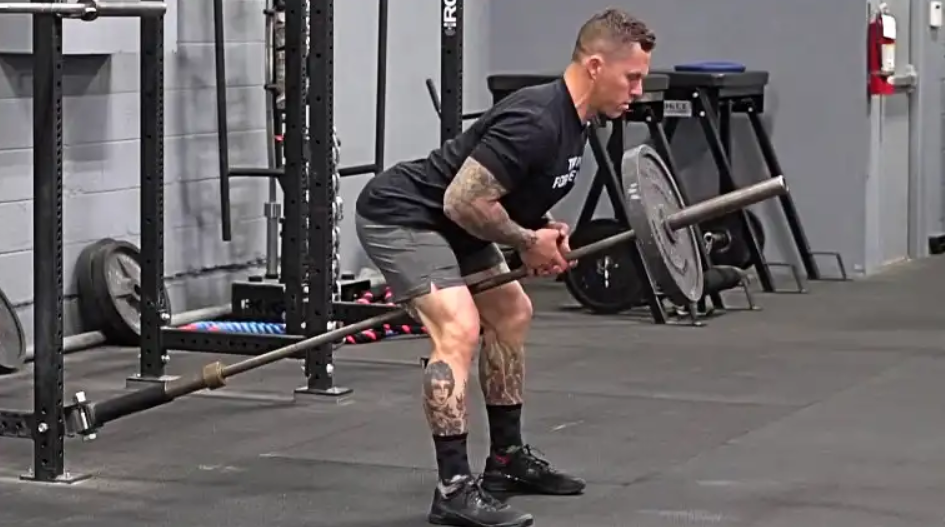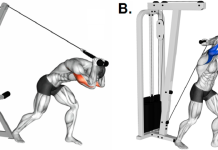Landmine Row: Mastering the Ultimate Total-Body Strength Exercise
If you’re looking to take your strength training to the next level, the landmine row is a must-add exercise to your routine. This powerful movement engages multiple muscle groups, offering a comprehensive full-body workout. In this guide, we’ll explore the proper technique, various landmine row variations, and the targeted muscle groups to help you perfect your form and achieve maximum gains.

Proper Technique and Form
The key to unlocking the benefits of the landmine row lies in mastering the proper technique and form. Before diving into the exercise, ensure you have a stable landmine platform or landmine bar securely fixed. Here’s a step-by-step guide to executing the landmine row with precision:
- Setting Up the Landmine Attachment: Position the landmine attachment securely in a corner or on a landmine platform to provide stability during the exercise.
- Gripping and Positioning the Barbell: Stand with your feet shoulder-width apart, facing the landmine. Grip the barbell with an overhand grip, keeping your palms facing down.
- Body Position and Stance: Maintain a slight bend in your knees and hinge at your hips to create a flat back position. Your torso should be parallel to the floor, forming a 45-degree angle with the ground.
- Rowing Motion: With a controlled motion, pull the barbell towards your chest, keeping your elbows close to your body. Focus on engaging your back muscles throughout the movement.
- Lowering the Barbell: Slowly lower the barbell back to the starting position, maintaining tension in your muscles.
By following these steps and paying attention to your body’s alignment, you can perform the landmine row safely and effectively.
Muscle Groups Targeted
The landmine row is a dynamic exercise that targets several muscle groups, making it an efficient choice for total-body strength development. The primary muscles engaged during the landmine row include:
- Latissimus Dorsi (Lats): Located in your back, the lats are responsible for the pulling motion during the row.
- Rhomboids and Trapezius: These muscles in your upper back and neck assist in stabilizing the movement.
- Biceps and Forearms: As you grip and row the barbell, your biceps, and forearms come into play.
- Core Muscles: Your core plays a crucial role in stabilizing your body during exercise, promoting balance and posture.
Incorporating the landmine row into your workout routine can help you develop a well-rounded physique and improve your overall functional strength.
Landmine Row Variations
To keep your workouts engaging and challenging, you can explore various landmine row variations. Each variation targets specific muscle groups, providing a unique training stimulus. Some popular landmine row variations include:
- Single-Arm Landmine Row: Perform the standard landmine row with one arm at a time, allowing for focused muscle engagement and improved balance.
- Bent-Over Landmine Row: Instead of standing, bend at the hips to perform the row while maintaining a flat back position. This variation adds an extra challenge to your core and lower back muscles.
- T-Bar Landmine Row: Attach a T-bar handle to the landmine platform for a different grip and range of motion, targeting your back and arms from a different angle.
By incorporating these variations into your routine, you can continually challenge your muscles and avoid plateaus in your strength training journey.
Landmine T-Bar Row: A Unique Twist on Traditional Rowing
The landmine T-bar row is a fantastic variation that combines the benefits of the landmine row with the traditional T-bar row. By using the landmine attachment, you can perform the T-bar row with greater stability and control.
To execute the landmine T-bar row:
- Setup: Securely fix one end of the barbell into the landmine attachment, ensuring it’s stable and won’t move during the exercise.
- Grip and Positioning: Stand with your feet shoulder-width apart, facing the landmine. Grab the barbell with both hands, palms facing each other.
- Body Position and Stance: Hinge at your hips, keeping your back straight and your chest up. Your torso should be at a slight angle to the floor.
- Rowing Motion: Pull the barbell towards your torso, squeezing your shoulder blades together as you lift. Keep your elbows close to your body during the movement.
- Lowering the Barbell: Slowly lower the barbell back to the starting position, maintaining control throughout the descent.
The landmine T-bar row targets the lats, rhomboids, trapezius, and biceps, providing a comprehensive upper-body workout. It also engages your core and lower back muscles for stability during the exercise.
Landmine Bar: A Versatile Tool for Strength Training
The landmine bar is a versatile piece of equipment that can be used for a wide range of exercises, including the landmine row. This angled barbell attachment allows for various grip positions and angles, giving you the freedom to target different muscle groups effectively.
To perform the landmine row with the landmine bar:
- Setup: Position the landmine bar securely in a corner or on a landmine platform to ensure stability during the exercise.
- Grip and Positioning: Stand with your feet shoulder-width apart, facing the landmine. Grip the landmine bar with an overhand grip, palms facing down.
- Body Position and Stance: Maintain a slight bend in your knees and hinge at your hips, creating a flat back position. Your torso should be parallel to the floor.
- Rowing Motion: Pull the landmine bar towards your chest, focusing on engaging your back muscles and squeezing your shoulder blades together.
- Lowering the Bar: Gradually lower the bar back to the starting position in a controlled manner, maintaining tension in your muscles.
The landmine bar allows for different grip variations, such as neutral, pronated, or supinated grips, which can alter the muscle emphasis during the rowing motion. It is an excellent tool for building upper body strength and can be incorporated into various workout routines.
T-Bar Landmine Row: Combining Stability and Intensity
The T-bar landmine row is a modification of the traditional T-bar row, using the landmine attachment for added stability and control. This variation enables you to target your back muscles with precision, making it ideal for individuals looking to enhance their back strength and muscle definition.
Here’s how to perform the T-bar landmine row:
- Setup: Secure one end of the barbell into the landmine attachment to ensure stability during the exercise.
- Grip and Positioning: Stand with your feet shoulder-width apart, facing the landmine. Grip the barbell with both hands, palms facing each other.
- Body Position and Stance: Hinge at your hips, maintaining a flat back position and a slight bend in your knees. Your upper body should be at a 45-degree angle to the floor.
- Rowing Motion: Pull the barbell towards your torso, focusing on engaging your back muscles and retracting your shoulder blades.
- Lowering the Barbell: Lower the barbell back to the starting position with controlled movements, avoiding jerking or swinging.
The T-bar landmine row provides a stable platform for executing the rowing motion, allowing you to lift heavier weights safely. This exercise effectively targets your lats, rhomboids, and trapezius muscles, contributing to a well-defined and strong back.
Landmine Platform: Enhancing Stability and Range of Motion
A landmine platform is a valuable accessory for landmine exercises, including the landmine row. This platform provides a sturdy base for the landmine attachment, offering enhanced stability and a more extensive range of motion during the exercise.
To utilize the landmine platform for the landmine row:
- Setup: Position the landmine platform securely on the ground or against a stable surface.
- Attaching the Landmine: Insert the barbell into the landmine attachment, ensuring it is firmly fixed on the platform.
- Grip and Positioning: Stand with your feet shoulder-width apart, facing the landmine platform. Grip the barbell with an overhand grip, palms facing down.
- Body Position and Stance: Hinge at your hips and bend your knees slightly, creating a flat back position. Your upper body should be at an angle to the floor.
- Rowing Motion: Pull the barbell towards your chest, keeping your elbows close to your body. Focus on engaging your back muscles throughout the movement.
- Lowering the Barbell: Lower the barbell back to the starting position with controlled movements, avoiding rapid descent.
The landmine platform enhances the safety and effectiveness of the landmine row, providing stability as you perform the exercise. It also allows for a deeper range of motion, further engaging your back and upper body muscles.
Landmine Row Machine: An Efficient Total-Body Workout
The landmine row machine offers a dedicated setup for performing landmine rows with ease and precision. This specialized equipment ensures proper form and stabilizes the barbell, allowing you to focus solely on maximizing your back and upper body engagement.
To use the landmine row machine effectively:
- Setup: Adjust the machine’s seat and foot placement to ensure proper alignment and comfort during the exercise.
- Grip and Positioning: Sit on the machine’s seat and grip the barbell with an overhand grip, palms facing down.
- Body Position and Stance: Place your feet firmly on the footrest and maintain a straight back with your chest up.
- Rowing Motion: Pull the barbell towards your chest, keeping your elbows close to your body and engaging your back muscles.
- Lowering the Barbell: Slowly lower the barbell back to the starting position, maintaining control throughout the movement.
The landmine row machine streamlines the exercise, making it accessible for users of all fitness levels. It offers a convenient alternative to traditional landmine setups, making it an excellent addition to any gym or home workout space.
Landmine Row Exercise: Unlocking Full-Body Strength
The landmine row exercise is a compound movement that engages multiple muscle groups, making it a highly effective exercise for building full-body strength. By incorporating the landmine row into your routine, you can target various muscles simultaneously and enhance your overall functional fitness.
Key benefits of the landmine row exercise include:
- Upper Body Strength: The landmine row primarily targets your back muscles, including the lats, rhomboids, and trapezius, promoting a stronger and more defined upper body.
- Core Stabilization: The rowing motion requires core engagement for stability, helping improve core strength and balance.
- Improved Posture: Regularly performing landmine rows can lead to better posture, as it targets muscles responsible for maintaining an upright stance.
- Versatility: With various landmine row variations available, you can customize your workouts to focus on specific muscle groups or create dynamic total-body sessions.
Integrating the landmine row exercise into your training routine can elevate your performance in other activities and sports, making it a valuable addition to any fitness program.
Landmine Row to Press: Combining Strength and Shoulder Development
The landmine row-to-press is a powerful compound exercise that combines the benefits of the landmine row with an overhead press. This movement engages your upper body and shoulders, providing an efficient way to develop both strength and shoulder muscle definition.
To perform the landmine row press:
- Setup: Position the landmine attachment or barbell securely and assume the starting position for the landmine row.
- Rowing Motion: Execute the landmine row by pulling the barbell towards your chest, engaging your back muscles.
- Transition to Press: After completing the row, rotate your body slightly and press the barbell overhead, extending your arms fully.
- Lowering the Barbell: Gradually lower the barbell back to the starting position, and then release the rowing motion.
The landmine row to press is a challenging yet rewarding exercise that targets your back, shoulders, and arms. It effectively strengthens multiple muscle groups and enhances upper body stability and power.
Chest Supported Landmine Row: Targeting Back Muscles with Precision
The chest-supported landmine row is a variation of the traditional landmine row, performed with the added support of a bench. This exercise isolates the back muscles and minimizes the involvement of other body parts, allowing for targeted and controlled movements.
Here’s how to perform the chest-supported landmine row:
- Setup: Set an adjustable bench at a 45-degree angle. Place the landmine attachment or barbell at the end of the bench.
- Grip and Positioning: Lie face down on the bench with your chest supported. Grip the barbell with an overhand grip, palms facing down.
- Body Position and Stance: Keep your feet firmly planted on the ground and maintain a flat back throughout the exercise.
- Rowing Motion: Pull the barbell towards your chest, focusing on engaging your back muscles and retracting your shoulder blades.
- Lowering the Barbell: Lower the barbell back to the starting position in a controlled manner, maintaining tension in your back muscles.
A chest-supported landmine row is an excellent option for individuals with lower back issues or those looking to isolate their back muscles more effectively. It’s a safe and challenging exercise to include in your upper body strength routine.
Landmine Row Grip Variations: Customizing Your Workout
The landmine row offers various grip variations, allowing you to customize your workout and target specific muscle groups more precisely. Experimenting with different grips can add diversity to your training and stimulate muscle growth from various angles.
Some common landmine row grip variations include:
- Overhand Grip: The traditional overhand grip targets the overall back muscles, with an emphasis on the lats and rhomboids.
- Underhand Grip (Supinated Grip): This grip variation shifts the focus to the biceps and upper back, providing a unique angle of engagement.
- Neutral Grip (Parallel Grip): The neutral grip targets the middle back and offers a more joint-friendly option for individuals with wrist issues.
- Mixed Grip: With one hand in an overhand grip and the other in an underhand grip, the mixed grip targets both sides of the back simultaneously.
- Wide Grip: Placing your hands wider apart on the barbell engages the outer back muscles, contributing to a broader back appearance.
- Close Grip: Bringing your hands closer together on the barbell emphasizes the middle back muscles, providing a better definition.
By incorporating these grip variations into your landmine row routine, you can optimize muscle development and prevent plateaus in your strength training journey.
Common Mistakes to Avoid During Landmine Rows
While landmine rows are highly beneficial, certain common mistakes can hinder their effectiveness or lead to injuries. To ensure a safe and productive workout, avoid the following errors:
- Using Momentum: Avoid using momentum to lift the barbell. Focus on controlled movements and engage your back muscles throughout the exercise.
- Rounding the Back: Maintain a flat back and avoid rounding your spine during the rowing motion to prevent strain on your lower back.
- Overarching the Back: Similarly, avoid excessive arching of the back, as it can lead to unnecessary pressure on your spine.
- Neglecting Core Engagement: Engage your core throughout the exercise to stabilize your body and prevent excessive swaying.
- Lifting Too Heavy: Start with a manageable weight and gradually increase as you build strength and confidence.
- Neglecting Range of Motion: Lower the barbell fully to experience the full benefits of the exercise and maximize muscle engagement.
By being mindful of these mistakes, you can perform landmine rows effectively and safely, reaping the full rewards of this versatile strength-building exercise.
Incorporating Landmine Rows into Your Workout Routine
Adding landmine rows to your workout routine can be a game-changer for your strength and muscle development. Here are some effective ways to incorporate this versatile exercise into your training program:
- Upper Body Strength Day: Designate a day solely for upper body strength training and include landmine rows as a key exercise. Combine them with other compound movements like bench presses and shoulder presses for a complete upper-body workout.
- Back and Biceps Focus: Create a workout session that targets your back and biceps. Landmine rows can be the star of the show, complemented by exercises like pull-ups, seated rows, and bicep curls.
- Super Set Challenge: Superset landmine rows with a complementary exercise to maximize muscle engagement and save time. For example, alternate landmine rows with push-ups to work your entire upper body.
- Total Body Circuit: Integrate landmine rows into a total body circuit routine. Combine them with squats, lunges, and overhead presses to achieve a full-body burn.
- HIIT Landmine Workout: Incorporate landmine rows into a high-intensity interval training (HIIT) session. Alternate between landmine rows and other dynamic exercises for a cardio-infused strength workout.
Landmine Row Variations: Progression and Challenge
As you become more comfortable with landmine rows, it’s essential to challenge yourself with different variations to keep your progress on track. Here are some advanced landmine row variations to take your strength training to the next level:
- Single-Arm Landmine Row: Perform the row using one arm at a time, focusing on balance and stability. This variation targets each side of your back independently, enhancing muscle symmetry.
- Landmine Renegade Row: Combine landmine rows with a renegade row motion to engage your core and improve overall body coordination.
- Landmine Meadows Row: Adopt a split stance and lean over the landmine for the meadows row variation. This targets the lower lats and provides a unique challenge.
- Landmine T-Bar Row: Set up the landmine attachment to resemble a T-bar machine and perform rows with a wider range of motion, targeting the middle back.
- Landmine Push-Pull Circuit: Alternate between landmine rows and landmine presses in a push-pull circuit. This combination elevates your heart rate and boosts both upper body strength and endurance.
Recovery and Proper Form
As with any exercise, prioritizing recovery is crucial to avoid overtraining and injury. Allow your muscles adequate time to rest and recover between intense workouts that include landmine rows.
Additionally, maintaining proper form during landmine rows is essential for optimizing results and minimizing the risk of injury. Keep your back straight, engage your core, and perform the movement in a controlled manner.
The landmine row is a highly effective compound exercise that targets multiple muscle groups, making it a valuable addition to any strength training regimen. Whether you’re a seasoned fitness enthusiast or just beginning your fitness journey, incorporating landmine rows can help you build a stronger, more balanced physique.
FAQs About Landmine Rows: Mastering the Technique and Benefits
What muscles do landmine rows work?
Landmine rows primarily target the back muscles, including the lats, rhomboids, and trapezius. They also engage the biceps, rear deltoids, and core for stability.
Can beginners do landmine rows?
Yes, beginners can perform landmine rows with proper guidance and form. Start with lighter weights to master the technique before progressing to heavier loads.
What equipment do I need for landmine rows?
You’ll need a landmine attachment, a barbell, and a secure anchor point or landmine platform to perform landmine rows.
Are landmine rows safe for the lower back?
When executed with proper form, landmine rows are generally safe for the lower back. However, individuals with existing lower back issues should consult a fitness professional or healthcare provider before attempting this exercise.
Can landmine rows be done with dumbbells?
Yes, you can perform landmine rows with dumbbells by placing the dumbbell next to a sturdy object, such as a wall or a corner.
How do I prevent shoulder strain during landmine rows?
Maintain a neutral wrist position, retract your shoulder blades, and avoid overextending your arms to prevent shoulder strain.
What is the difference between landmine rows and T-bar rows?
Landmine rows involve a barbell anchored at one end, while T-bar rows use a T-bar machine. Landmine rows offer a greater range of motion and require less setup.
Can landmine rows help improve posture?
Yes, landmine rows can strengthen the back muscles responsible for maintaining good posture, contributing to improved alignment.
Are landmine rows suitable for women?
Absolutely! Landmine rows are beneficial for both men and women, helping to tone and strengthen the upper body.
How many sets and reps should I do for landmine rows?
It depends on your fitness level and goals. A typical range is 3-4 sets of 8-12 reps per side.
Can I use a landmine attachment at home?
Yes, a landmine attachment can be used at home if you have a secure anchor point and sufficient space for exercise.
Are landmine rows better for building muscle compared to other back exercises?
Landmine rows are effective for building muscle, but they work best when combined with a variety of back exercises for overall muscle development.
Can landmine rows be part of a full-body workout?
Yes, landmine rows can be incorporated into a full-body workout routine to engage multiple muscle groups simultaneously.
Is it normal to feel sore after doing landmine rows?
Feeling mild soreness in the targeted muscle groups is normal after performing landmine rows. Ensure proper warm-up and cool-down to minimize discomfort.
Can I do landmine rows with a resistance band?
Yes, resistance bands can be used as an alternative to barbells for landmine rows. Secure the band to an anchor point and follow the same rowing motion.
How often should I do landmine rows per week?
It’s recommended to include landmine rows in your strength training routine 1-2 times per week, with sufficient rest between sessions.
Can landmine rows be included in a weight loss program?
Yes, landmine rows can be part of a weight loss program as they contribute to calorie burn and muscle development.
Should I do landmine rows before or after other exercises?
Perform landmine rows as part of your upper body workout. Consider starting with compound movements before moving on to isolated exercises.
Are landmine rows suitable for athletes?
Yes, landmine rows are suitable for athletes of various sports, as they enhance upper body strength and stability.
Can landmine rows help with posture-related back pain?
Strengthening the back muscles through landmine rows can potentially alleviate posture-related back pain. However, consult a healthcare professional for personalized advice.




